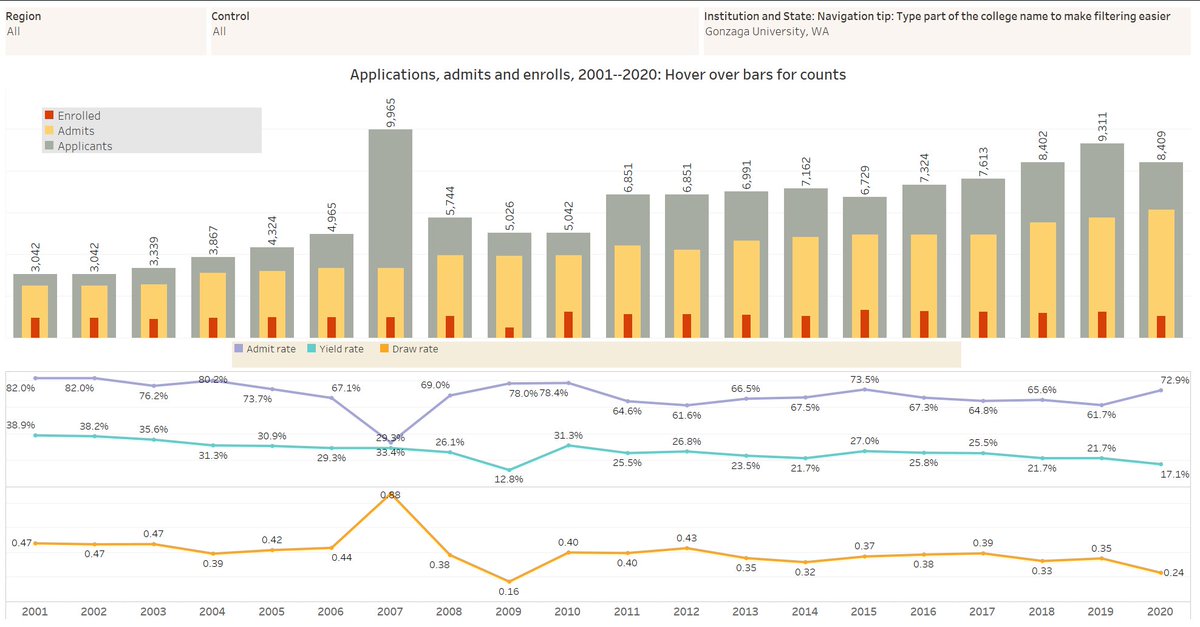
Thread: Do you remember when your mom said your eyes would stick that way if you crossed them?
And have you heard about the Flutie effect? Do you believe them? Follow along.
And have you heard about the Flutie effect? Do you believe them? Follow along.
First, let's look at some NCAA Cinderella teams. Check out this article here: ncaa.com/news/basketbal…
Now let's look at admissions results in the years following, and in the longer term (where possible.)
George Mason, 2006, saw a bump in 2007, but a drop in 2008. It's admit rate has increased, and its yield and draw rates have fallen since then.
George Mason, 2006, saw a bump in 2007, but a drop in 2008. It's admit rate has increased, and its yield and draw rates have fallen since then.

Davidson, 2008: Apps dropped in 2010 after increasing slightly in 2009. They've seen nice, steady increases since then, like almost all selective liberal arts colleges. 

Butler 2010 and 2011. Nice bump the first year, which stabilized really quickly. Admit rates are still in the mid-70s and yield has been cut in half since then. 

Florida Gulf Coast, 2013. They got a nice bump and have sustained it, mostly. Their admit rate has gone up, and yield rate down. since then, as has their draw. 

Loyola of Chicago, 2018. If Sister Jean can't increase your apps, well, who can? (I believe they just joined Common App, however, which will do more for them than basketball did.) 

UMBC 2018. Not much to see here, either, although let's say COVID might have interfered with their plans. 

Oral Roberts, 2021? Too soon to tell, of course (IPEDS data is only current up to 2020 as of this point.)
Here is the national data, by the way. And you can look up your favorite college here: highereddatastories.com/2022/01/yes-yo… 

But, you say, some of these bumps, although small are real. Yes, they are.
What did it cost to get them? I don't think any of these institutions are among the small sample where athletics pay for themselves, which means they're subsidized. There is nothing wrong with that.
What did it cost to get them? I don't think any of these institutions are among the small sample where athletics pay for themselves, which means they're subsidized. There is nothing wrong with that.
Colleges subsidize a lot of things, because they believe there is value. My point is this: If you want to believe your trip to the Sweet 16 "paid off" you need to tally the costs of several years or decades of getting there.
That's how finance works.
That's how finance works.
Colleges suffer from imitation complex. They want to be like the big, well known universities. That, I believe, is why most of them started requiring the SAT. That's why some of them invest heavily in athletics.
My gut tells me it's a fool's game.
My gut tells me it's a fool's game.
*Maybe* alumni happiness is worth it. *Maybe* donations increase. But for those lesser-known, more regional institutions, it's hardly sustainable. You have to win year after year.
Yes, BC. Yes, Villanova. Yes, Georgetown. They started from higher places. Even Gonzaga, which has had years of good runs, isn't blowing the doors off of things. (These are good numbers...not outstanding ones.) 

So again, athletics is rightfully a big part of many small and large universities. That's not the problem.
Our collective fascination in fairy tales, specifically the value of Cinderella stories and their effect on enrollments, is.
Just. Look. At. The. Data. It's right there.
Our collective fascination in fairy tales, specifically the value of Cinderella stories and their effect on enrollments, is.
Just. Look. At. The. Data. It's right there.
It's fun to cheer for St. Peter's. I'm cheering for St. Peter's. But it's unlikely St. Peter's is going to turn into Princeton with a few wins in a basketball tournament.
Even if they win the whole thing. Sorry, that slipper won't fit.
Even if they win the whole thing. Sorry, that slipper won't fit.
Oh, and #EMTalk
• • •
Missing some Tweet in this thread? You can try to
force a refresh











